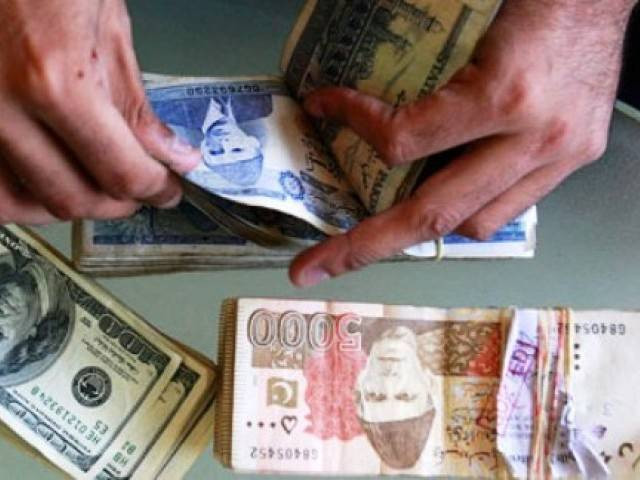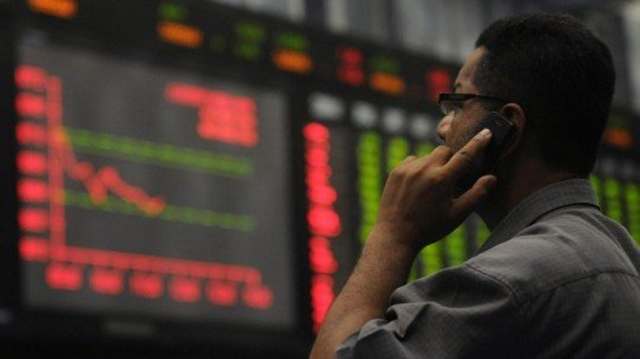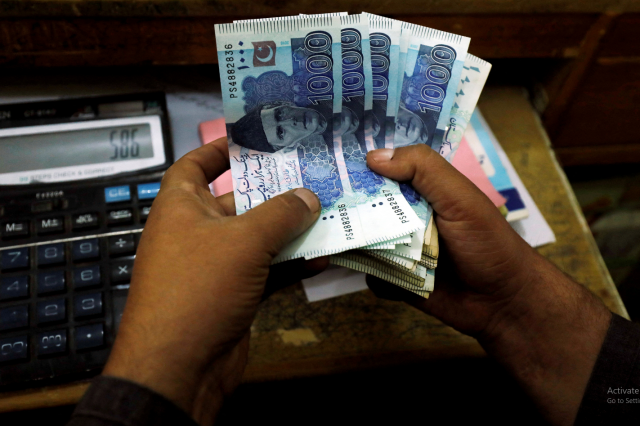Business
PSX continues upward momentum amid institutional buying, oil sector boost – SUCH TV

The Pakistan Stock Exchange (PSX) extended its bullish streak on Wednesday, fueled by strong institutional buying, partial disbursement of remittance incentives, and renewed investor confidence across key sectors—particularly oil and gas.
The benchmark KSE-100 Index surged to an intraday high of 144,209.03 points, gaining 1,171.87 points or 0.82%. Earlier in the day, it had touched a low of 143,409.59, still up by 372.43 points or 0.26% from the previous close of 143,037.16.
“A series of positive developments, including a technical breakout above the 140,000 level, has sparked fresh buying, especially in the oil sector following payments to OGDCL,” said Ahfaz Mustafa, CEO of Ismail Iqbal Securities.
Adding to the market’s momentum, the government approved Rs30 billion out of the Rs58 billion pending claims under the Telegraphic Transfer Charges Incentives Scheme (TTCIS), aimed at boosting remittance inflows.
The TTCIS, initiated in 1985, provides a zero-cost send model for eligible remittance transactions.
The reimbursement backlog, caused by a surge in home remittances exceeding allocated funds, will now be cleared in phases through technical supplementary grants.
Separately, the government plans to borrow Rs6.175 trillion from commercial banks via Treasury bills and Pakistan Investment Bonds (PIBs) between August and October, according to the auction calendar issued by the State Bank of Pakistan (SBP).
This includes Rs3.675 trillion in T-bills of varying maturities and Rs2.5 trillion in fixed and floating-rate PIBs.
The strategy, designed to pre-fund budgetary needs ahead of potential monetary easing, aligns with IMF commitments to avoid central bank borrowing.
The SBP held its benchmark interest rate at 11% last week, citing renewed inflation concerns.
Since June 2024, the policy rate has been reduced by 1,100 basis points from a high of 22%.
Meanwhile, Oil and Gas Development Company Ltd (OGDCL) confirmed it received the first Rs7.7 billion interest payment from Power Holding Private Ltd (PHPL) as part of a long-delayed Rs132.7 billion circular debt settlement.
The repayment stems from term finance certificates (TFCs) issued in 2013, with interest payments scheduled through mid-2026.
OGDCL had previously recognised the interest income over the TFCs’ lifecycle, with a carrying value of Rs170 billion as of March 2024.
The firm had booked a Rs23 billion loss due to discounted payment valuation, of which Rs10.6 billion had been reversed by March 2025.
On Tuesday, the Pakistan Stock Exchange (PSX)’s benchmark KSE-100 index closed the trading session at 143,037.16.
The index remained positive throughout the day, reaching an intraday high of 143,281.35 (+1,228.7) and a low of 142,235.71 (+183.07) points.
Business
Consumer tech expansion: Philips to widen India portfolio with global products; focus on male grooming, mother and child care – The Times of India

Philips India is set to broaden its footprint in the domestic market by introducing more global product lines and strengthening its offerings in male grooming and mother and child care, responding to rising consumer demand for premium personal care products.The company, which recently rolled out its rechargeable intimate skin-protect grooming product, OneBlade, aimed at Gen Z consumers, said the premium segment is seeing robust growth, highlighting a shift in Indian consumer preferences, PTI reported.“We will continue strengthening male grooming and mother and childcare with newer and newer innovations, and we continue to get our global categories, which are huge in other markets, into India,” said Smit Shukla, Head of Philips Personal Health India Subcontinent.He added that Philips has a large global portfolio in oral care, and the company is assessing strategies to drive consumer demand before introducing these products in India.According to Vidyut Kaul, Head of Personal Health, Philips Growth Region (JAPAC, ISC, META & LATAM), the non-manual grooming market in India has been expanding at a mid-to-high single-digit growth rate annually over the last five years.In the grooming segment, Philips India enjoys a 50-60 per cent market share, depending on the sales channel, Kaul said, underscoring the brand’s leadership position.He added that while Philips has long been a global innovation leader, the company had earlier avoided introducing premium innovations in India due to perceptions of it being a price-sensitive market. However, he said, “It is not price-sensitive but value-conscious, and we are seeing that premiumisation is fast catching up.”The company’s most premium shaver, launched in April this year, received a strong consumer response, with demand outpacing supply, he said. Philips has witnessed over 75 per cent growth in the premium segment, driven by this shift in consumer sentiment.The male grooming segment continues to be one of the top growth drivers for Philips in India, followed by the mother and child care segment, both of which have performed strongly over the past 2–3 years.“They continue to boost more and more growth and give access to the consumers. In addition, the personal care and personal grooming segments will further accelerate the growth journey there,” Kaul said.He also noted that Philips has enhanced localisation in its manufacturing operations under its ‘local-for-local’ strategy, which has helped shield the company from the impact of rising US tariffs.
Business
Women in banking: SBI aims for 30% female workforce by 2030; steps up inclusion and health initiatives – The Times of India

The State Bank of India (SBI) has set a target to raise the share of women in its workforce to 30 per cent by 2030 as part of a broader push to strengthen gender diversity and inclusivity across all levels of the organisation.SBI Deputy Managing Director (HR) and Chief Development Officer (CDO) Kishore Kumar Poludasu told PTI that women currently account for about 27 per cent of the bank’s total workforce, though the figure rises to nearly 33 per cent among frontline staff.“We will be working towards improving this percentage so that diversity gets further strengthened,” Poludasu said, adding that the bank is taking targeted measures to bridge the gap and meet its medium-term diversity goal.With a staff strength of over 2.4 lakh — among the highest for any organisation in the country — SBI has rolled out several initiatives aimed at creating a workplace where women can thrive professionally while maintaining work-life balance.Among the women-centric measures, the bank offers creche allowances for working mothers, a family connect programme, and dedicated training sessions to help women re-enter the workforce after maternity, sabbatical, or extended sick leave.Poludasu said SBI’s flagship initiative, Empower Her, is designed to identify, mentor, and groom women employees for leadership roles through structured leadership labs and coaching sessions. The programme aims to strengthen the pipeline of women leaders across the organisation.The bank has also introduced wellness initiatives tailored to women’s health needs, including breast and cervical cancer screenings, nutritional allowances for pregnant employees, and a cervical cancer vaccination drive.“These programmes are designed keeping in mind the women and girls who are employed in the bank,” Poludasu said, adding that SBI remains committed to fostering an inclusive, secure, and empowering workplace.Currently, the lender operates over 340 all-women branches across India, and the number is expected to increase in the coming years.SBI, one of the world’s top 50 banks by asset size, has also been recognised among India’s best employers by multiple organisations. Poludasu said the bank continues to drive innovation across processes, technology, and customer experience while ensuring that diversity and inclusion remain central to its transformation journey.
Business
Trade talks: India, EU wrap up 14th round of FTA negotiations; push on to seal deal by December – The Times of India

India and the 27-nation European Union (EU) have concluded the 14th round of negotiations for a proposed free trade agreement (FTA) in Brussels, as both sides look to resolve outstanding issues and move closer to signing the deal by the end of the year, PTI reported citing an official.The five-day round, which began on October 6, focused on narrowing gaps across key areas of trade in goods and services. Indian negotiators were later joined by Commerce Secretary Rajesh Agrawal in the final days to provide additional momentum to the talks.During his visit, Agrawal held discussions with Sabine Weyand, Director General for Trade at the European Commission, as both sides worked to accelerate progress on the long-pending trade pact.Commerce and Industry Minister Piyush Goyal recently said he was hopeful that the two sides would be able to sign the agreement soon. Goyal is also expected to travel to Brussels to meet his EU counterpart Maros Sefcovic for a high-level review of the progress made so far.Both India and the EU have set an ambitious target to conclude the negotiations by December, officials familiar with the matter said, PTI reported.Negotiations for a comprehensive trade pact between India and the EU were relaunched in June 2022 after a hiatus of more than eight years. The process had been suspended in 2013 due to significant differences over market access and tariff liberalisation.The EU has sought deeper tariff cuts in sectors such as automobiles and medical devices, alongside reductions in duties on products including wine, spirits, meat, and poultry. It has also pressed for a stronger intellectual property framework as part of the agreement.For India, the proposed pact holds potential to make key export categories such as ready-made garments, pharmaceuticals, steel, petroleum products, and electrical machinery more competitive in the European market.The India-EU trade pact talks span 23 policy chapters covering areas such as trade in goods and services, investment protection, sanitary and phytosanitary standards, technical barriers to trade, rules of origin, customs procedures, competition, trade defence, government procurement, dispute resolution, geographical indications, and sustainable development.India’s bilateral trade in goods with the EU stood at $136.53 billion in 2024–25, comprising exports worth $75.85 billion and imports valued at $60.68 billion — making the bloc India’s largest trading partner for goods.The EU accounts for nearly 17 per cent of India’s total exports, while India represents around 9 per cent of the bloc’s overall exports to global markets. Bilateral trade in services between the two partners was estimated at $51.45 billion in 2023.
-

 Tech6 days ago
Tech6 days agoI’ve Tested Countless Mesh Systems. Here Are the Routers I Recommend
-

 Tech1 week ago
Tech1 week agoAll Hail the Surprisingly Versatile Packing Cube! These Are Our Favorites
-

 Tech1 week ago
Tech1 week agoAI in an ‘industrial bubble’ but will benefit society: Bezos
-

 Tech1 week ago
Tech1 week agoAmazon Prime Big Deal Days Is Next Week, but We Already Found 40 Early Deals
-

 Tech1 week ago
Tech1 week agoAmazon is overhauling its devices to take on Apple in the AI era
-

 Tech6 days ago
Tech6 days agoJony Ive Says He Wants His OpenAI Devices to ‘Make Us Happy’
-

 Business1 week ago
Business1 week agoInvestors are packing up; Pakistan must ask why | The Express Tribune
-

 Sports1 week ago
Sports1 week agoAhead of India clash, Pakistan’s Fatima Sana says focus solely on ‘game’














